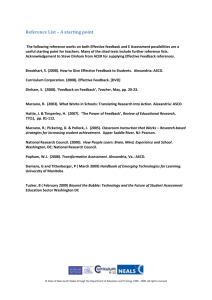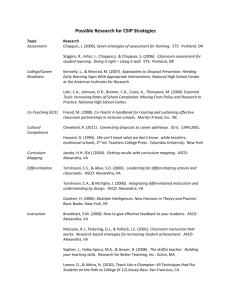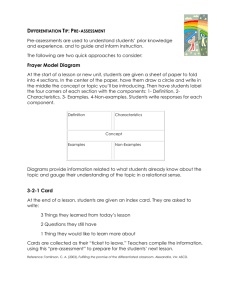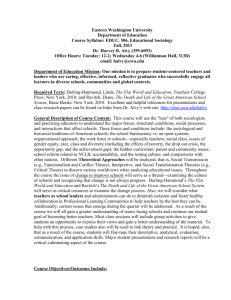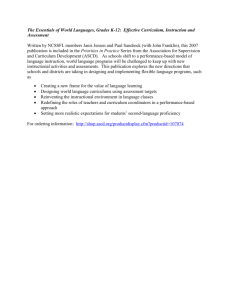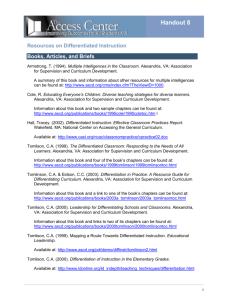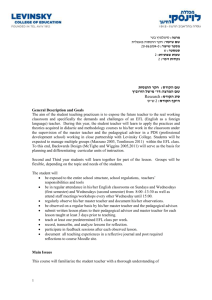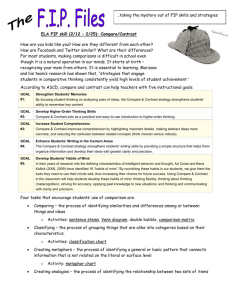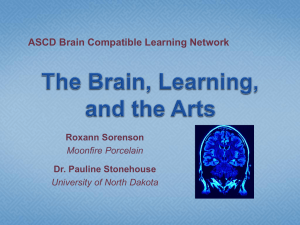Leadership for Today's Schools - Eastern Washington University
advertisement
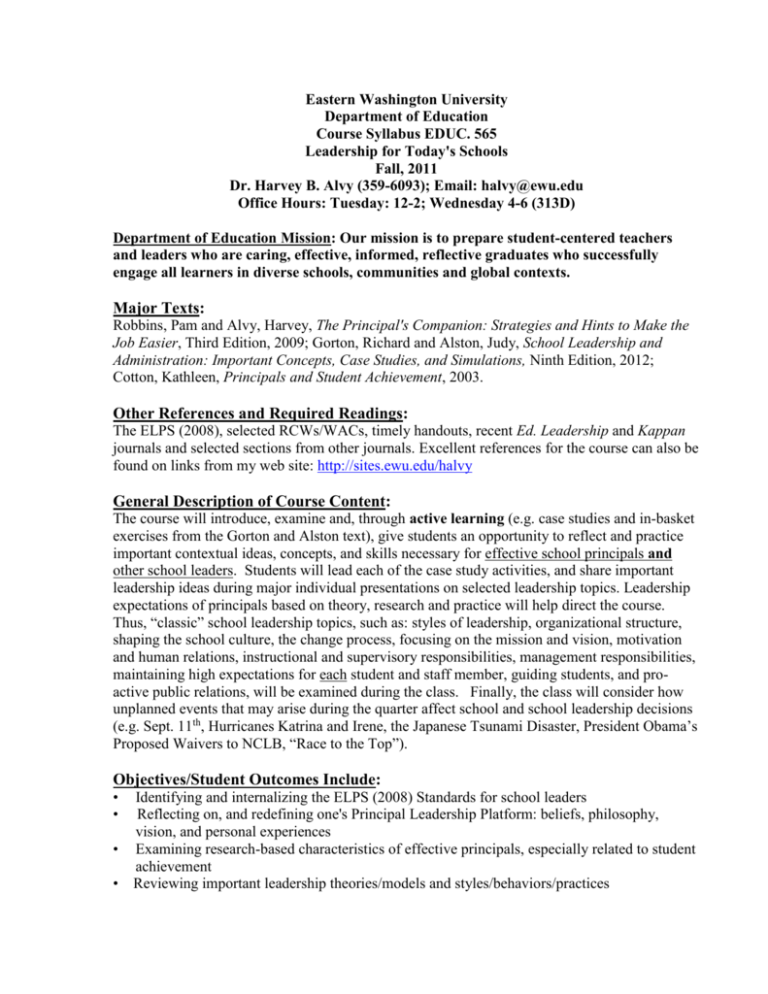
Eastern Washington University Department of Education Course Syllabus EDUC. 565 Leadership for Today's Schools Fall, 2011 Dr. Harvey B. Alvy (359-6093); Email: halvy@ewu.edu Office Hours: Tuesday: 12-2; Wednesday 4-6 (313D) Department of Education Mission: Our mission is to prepare student-centered teachers and leaders who are caring, effective, informed, reflective graduates who successfully engage all learners in diverse schools, communities and global contexts. Major Texts: Robbins, Pam and Alvy, Harvey, The Principal's Companion: Strategies and Hints to Make the Job Easier, Third Edition, 2009; Gorton, Richard and Alston, Judy, School Leadership and Administration: Important Concepts, Case Studies, and Simulations, Ninth Edition, 2012; Cotton, Kathleen, Principals and Student Achievement, 2003. Other References and Required Readings: The ELPS (2008), selected RCWs/WACs, timely handouts, recent Ed. Leadership and Kappan journals and selected sections from other journals. Excellent references for the course can also be found on links from my web site: http://sites.ewu.edu/halvy General Description of Course Content: The course will introduce, examine and, through active learning (e.g. case studies and in-basket exercises from the Gorton and Alston text), give students an opportunity to reflect and practice important contextual ideas, concepts, and skills necessary for effective school principals and other school leaders. Students will lead each of the case study activities, and share important leadership ideas during major individual presentations on selected leadership topics. Leadership expectations of principals based on theory, research and practice will help direct the course. Thus, “classic” school leadership topics, such as: styles of leadership, organizational structure, shaping the school culture, the change process, focusing on the mission and vision, motivation and human relations, instructional and supervisory responsibilities, management responsibilities, maintaining high expectations for each student and staff member, guiding students, and proactive public relations, will be examined during the class. Finally, the class will consider how unplanned events that may arise during the quarter affect school and school leadership decisions (e.g. Sept. 11th, Hurricanes Katrina and Irene, the Japanese Tsunami Disaster, President Obama’s Proposed Waivers to NCLB, “Race to the Top”). Objectives/Student Outcomes Include: • • • • Identifying and internalizing the ELPS (2008) Standards for school leaders Reflecting on, and redefining one's Principal Leadership Platform: beliefs, philosophy, vision, and personal experiences Examining research-based characteristics of effective principals, especially related to student achievement Reviewing important leadership theories/models and styles/behaviors/practices 2 • • • • • • • • • • Studying concepts of organizational structure from the business and educational fields Considering critical human relations skills linked to administration Studying issues related to ethical leadership, social justice, and diversity Identifying characteristics relating to effective school cultures and student achievement Considering the importance of a school's mission and vision Reviewing the change process: mobilization, implementation and institutionalization Recognizing the instructional leadership role of the principal through clinical supervision, curriculum support, differentiated professional growth options and supporting Teacher Leaders in Professional Learning Communities Considering the importance of balancing leadership and management responsibilities Considering the implications of crises (e.g., Sept. 11th ) for schools and principals Overviewing Washington State School Law related to teacher evaluation and principal expectations Using conflict resolution successfully Considering critical elements of the student program, such as: student guidance services, clubs, extra-curricular activities, community partnerships, and behavioral management Facilitating effective PR, and parent, community, and media support for the school Examining and simulating how principals effectively make decisions, prioritize, problem solve and communicate through cases studies and in-basket activities. Tentative Course Outline: September 27, 2011: A. Introduction to School Administration and The Challenge of the Principalship: Icebreaker, Review Syllabus, The ELPS Standards(2008), Begin examining “Contemporary Leadership Styles.” B. Case Study Analysis: We will discuss 24 recommended case study possibilities that you will review for class presentations. Pairs of students directing the case studies will begin on October 11th and end on November 15th. Harvey will present the first case study on October 4th. We will set aside time to discuss and assign each case study. Beyond the recommended case studies below, you may select another case study for your presentation, with Harvey's approval. The 23 recommended case study possibilities, all in Gorton and Alston are as follows: Interesting Case Study Possibilities Include: case study #1 p. 232 Preparing for the Job Search case study #2 p. 234 From Teacher to Administrator (Becoming a Principal) case study #6 p. 250 Do I Need to Act Like a Man to be a Leader? case study #7 p. 253 Dragging and Sagging case study #8 p. 256 Is Being Busy Necessarily Productive (Time Management) case study #9 p. 258 Changing Demographics and Teacher Attitudes (Multicultural Issues) case study #10 p. 261 Matter of What? (Racial Issues) case study #16 p. 277 "Zero Tolerance" for Weapons in Schools case study #18 p. 283 What to Do About the “Morning After”? case study #19 p. 285 Working with Students with Disabilities and IDEA case study #20 p. 287 Student-Formed Gay-Straight Alliance 3 case study #22 p. 296 case study #28 p. 311 case study #33 p. 328 case study #41 p. 351 case study #44 p. 361 case study #45 p. 362 case study #53 p. 391 case study #56 p. 397 case study #57 p. 399 case study #58 p. 402 case studies # 59 & 60 case study #63 p. 414 Problems of A Beginning Teacher Teacher Reacts Negatively to Personnel Evaluation Communication and Constructed Reality (Leads to Tragedy) Public Relations: What’s Really Important? Integration: A New Problem Parents Challenge Racial Disparity Teacher Tries to Individualize Instruction (The Innovative Teacher) School-Based Management Restructuring Staff Evaluation and Supervision Changing the Role of the Building Principal**** pp. 405-411 The Challenge of In-service Training (Parts I & II) When NCLB Meets You at Your School Door C. In-Basket Activities: 3, 4, 46, 47, Prioritizing and Implementing the Challenges that face school leaders--Harvey will review the dates of the in-basket activities and how to successfully manage the challenges of an in-basket. Please do not read in-baskets in advance! Assignments for October 4: Gorton and Alston, Chaps. 1, 2 (pp. 31-35; middle of page 37 to top of page 56); 8, and assigned case study # 21 on pp. 294-296; Robbins and Alvy Chaps. 1, 4, and review “Reflections” question #7 on page 9 and consider that question for each chapter; Cotton, Preface v-x, and Introduction, pp. 1-6. October 4, 2011: A. Compete work on “Contemporary Leadership Styles” B. How Organizations Are Structured: Theories and Models: Viewing models of how organizations are structured. Also, motivation, human relations, ethical practices, a global perspective, and the future implications of school leadership and student achievement will be introduced as important leadership themes for the course. B. Case Study Analysis. #21 pp. 294-296 C. In-basket Activity. Gorton and Alston, #4 pp. 242-248 Assignments for October 11: Gorton and Alston, Chaps. 6, 7, and assigned case study; Robbins and Alvy chaps. 3, 7, 8; Cotton, pp. 7-25. October 11, 2011: A. Exercising Leadership to Understand School Culture, Mission and Vision and the Change Process: Examining values, norms, storytelling, and the importance of collaboration strategies to understand school culture and implement the change process. Review effective schools research, how principals’ behavior can shape the culture, and the Washington State Model of “High Performing Schools.” B. Case Study Analysis 4 Assignments for October 18 and October 25: Gorton and Alston assigned case study for October 18th; Robbins and Alvy, chaps. 9, 10, 11, 12, 13, 14; Cotton pp. 25-45; October 18, 2011 A. Instructional and Curriculum Leadership I: Improving instruction by considering key instructional issues related to: clinical supervision, walk-throughs, the Student Learning Nexus Model, important curricular questions, collaboration, differentiated professional development growth options (including options for marginal teachers), Professional Learning Communities (PLCs), and faculty meetings as opportunities for growth. Also, review Cotton’s research-based strategies that principals use to support instructional improvement. B. Case Study Analysis. Assignment for October 25th: Continue readings from October 18th; One-page paired research presentation topic proposals are due on October 25th. October 25, 2011 A. Instructional and Curriculum Leadership II: (Complete discussion on this major topic from previous week). B. In-basket Exercise # 3: Gorton and Alston, pp. 236-242 (read, then reflect in pairs/or complete with partner). Assignment for November 1: Robbins and Alvy, Chapters 2, 5, 16, (and review pp. 98-100) Work on Principal Leadership Platform Paper Due November 8th. November 1, 2011: A. The Management Challenges of Instructional Leaders: TIPS to Improve Time Management Efficiency and “Leading and Learning By Wandering Around”. B. Washington State School Law : Examination of legal concerns addressed by the RCWs and the WACs related to evaluation of teacher (and new expectations) and principalship expectations (ELPS, and new state expectations). C. Case Study Analysis. Assignment for November 8, 2011: Gorton and Alston, Chapter 5; Robbins and Alvy, Chapter 18. Assigned case study; Review handout on legal issues. Principal Leadership Platform Paper Due. November 8, 2011 A. Conflict Resolution Suggestions for Principals: Using effective conflict resolution strategies with personnel and parents B. The Comprehensive and Proactive Student Services Program: The principal’s responsibilities related to guidance services, proactive behavioral strategies (e.g., bullying 5 prevention), parent and community partnership roles, and student activity planning (including extra-curricular activities), and the academic program. C. Activity with Principal Leadership Platform Papers D. Case Study Analysis. Assignment for November 15: Gorton and Alston Chapter 4, and assigned case study; Robbins and Alvy, Chaps. 17; Cotton, pp. 50-74. November 15, 2011 A. School, Parent, Community and Media Relations Through Effective Communication: Various roles played by principal as a: communicator and seeker of oral and written information, recognizing various constituencies, using different mediums of communication, and proactively partnering and leading activities, such as, “parent night activities”. B. Reflecting on Kathleen Cotton’s Research on the Relationship Between Principal’s Work and Student Achievement C. In-basket Activity, #46, pp. 366-373 , (Complete with partner). D. Case Study Analysis Assignments for November 22nd: Prepare for Presentations November 22, 2011 A. Paired Principal Leadership Presentations B. In-basket Activity, # 47, pp. 373-379. (choose activity format) Assignments for November 29th: Prepare for Presentations and Complete Research Reports November 29, 2011 Paired Principal Leadership Presentations Assignments for December 6, 2011: Review for Final Exam December 6, 2011: Final Examination 6 Evaluation/Assessment Procedures: (Note, regarding the rationale behind the forms of assessment: The quality/success of the course will depend a great deal on the individual and group contributions that we make. Effective school leaders are communicators, thoughtful decision makers, problem solvers, good listeners and REFLECTIVE PRACTITIONERS. Consequently, we will work on these skills together. ) Final grades will be based on the following five areas: 1. Readings, case study involvement, and class participation, includes presenting your insights/”ahas,” current thinking, concerns, new perspectives, each evening, completing in-basket activities, facilitating case study presentations, and role playing (thus, attendance is critical). 10%. (Note: If excessive absences occur I will use my discretion to penalize a student’s grade more than 10% because “real time” class interactions/activities/insights cannot be “duplicated.”) 2. Paired Case Study Presentations, Pairs of students will present case studies from the Gorton and Alston text to the class during each week from October 11th to November 15th. Case study presentations will be judged on: identifying important problems/issues, organization, planning and balancing time together, class engagement, effective questioning, creativity, insights, closing points, pacing, resources, and the overall quality of the presentation. 10% 3. Principal Leadership Platform Paper. A key objective of the course is to have each student study and examine the research, and general literature, on leadership and the principalship. This literature will help you generate a personal leadership platform paper and, consequently, a personal vision of leadership. Additionally, reading the literature will help you to identify, define, synthesize and reflect on important principles and ideas to develop your leadership philosophy, your 'personal compass'. Your philosophy, should become your practical reality. That is, how will you operate (behave) so that "your walk/behavior matches your talk”? Thus, the leadership platform should address all of the following questions and issues: a) Begin with a brief introductory section that describes how the paper will be organized. (Possibly including brief, preliminary, insights, sometimes students include a short quote in this section.) b) Telling your personal story: In this section you will reflect on your own story/narrative. What experiences, personal and professional, have helped to shape who you are? How does your story specifically relate to school leadership? c) What does the literature on the principalship indicate concerning effective leadership? Based on the literature you have read, develop 4-5 essential characteristics/principles of effective and successful school leaders (your developing philosophy) that you would like to internalize, or actualize, in a personal and professional manner. If you would like to create a visual model that “describes” the relationship between your leadership 7 principles and the sections below, feel free to do so in an appendix to the paper beyond the required pages. d) Assessing your skills: Review part “c” and the leadership characteristics/principles you described. Are the principles/characteristics are strengths for you? Explain. Which characteristics/principles are “skill areas” that need to be strengthened? Explain. Obviously, all individuals will have some areas of strengths and other areas that need strengthening (Leadership is humbling!). e) Select a specific challenge, issue or problem in your school that you would like to see solved/improved during “this” new school year. Then, proceed as follows: i) define the problem/issue, ii) provide 2 or 3 possible strategies to solve/improve the problem/issue, iii) select and describe the best solution, iv) explain how/if the solution "matches" your leadership philosophy. If cultural and/or diversity issues relate to your challenge, issue, or problem, make sure the issues are addressed in this section. f) Conclusions: What insights, new perspectives, concerns, and/or “ahas” emerge from your leadership platform? What did you learn about yourself? The Principal Leadership Platform should not exceed 10 pages, with double-spaced lines, a reasonable font size (12 Times), due on November 8, 2011. The platform should include a minimum of 5 works cited references (consider references in this syllabus on pages 9-12), other than the course textbooks. See http://research.ewu.edu/education The references should be noted primarily in part "c" of this assignment, and part "c" should embody a major part of your paper. The references should enrich your knowledge base, insights, and standard of the paper. The references, and your personal observations over the years, should greatly influence most of the ideas that you generate in the leadership platform paper. The platform should also include a separate title page and works cited page, in addition to headings and subheadings throughout the text (which function as a logical organizing outline, and hierarchy of heading importance). Use quotes sparingly—that is, use a direct quote only when you think an author states a point so effectively that you must use his/her exact words. Also, use the Publication Manual of the APA, (6th Edition) for formatting your narrative and works cited page. 20% 4. Paired Principal Leadership Presentations and Separate Research Papers (Paired Presentations 20%; Research Papers Graded Separately 20%): Students will make joint paired class presentations, and write separate research papers on topics critical to school leadership. The topic should present a leadership challenge, theme, problem, issue, dilemma, crisis, or paradox. The paired presentations and separate papers must include implications for school leaders “raised” by the topic. Those students who are going to be principal interns during the next couple of years or who are presently coaches in their schools should pair up together. Students who are presently not in regular classroom situations or who are not presently in the school leadership program also should pair up. Students will present the essential knowledge or “highlights” of the topic to the class in a 30-45 minute presentation on the evenings of 8 November 22nd and November 29th. As part of the presentation, paired groups will be expected to provide key ideas/highlights, new perspectives, concerns, and unique insights into the topic that only "experts" would be able to describe with simplicity and clarity. Select a topic that is important to both of you--select a passion! Select topics from one of the issues on our syllabus or a topic beyond the syllabus. Consider the “80%--20% Rule” when deciding on a topic—that is, make sure at least 80% of the information on the topic is new to both of you, as you build on 20% of familiar ideas. Stretch yourself! Present a one-page description proposal to Harvey for topic approval. Topics should be approved no later than week FIVE of the class (October 25, 2011). The final products will include the following: a) a 30-45 minute presentation--please rehearse your paired presentations to make sure it does not exceed 45 minutes. Again, the presentation should include topic highlights (usually 3-5 key points) to keep the audience interested; details should be saved for the “fact sheet” and the research paper. Try to have a good grasp of your material so you do not have to read “word for word” from your notes. During the presentation remember to share the key highlights and insights gained about leadership and the topic. A major presentation does not include minor details. Appropriate visual aids for the presentation, and handouts (for classmates) must be used to emphasize key points. Again, presentations will be made on the evenings of November 22nd and November 29th. b) a one-page "Key Facts Sheet" on the presentation topic to be distributed to classmates immediately before your presentation. Thus, the fact sheet will serve as a guide for the presentation. Students often include on the fact sheet excellent sources used during their research. This fact sheet must be an original document, organized and written by you. It should not be a pre-fabricated handout. However, you may attach pre-fabricated handouts to your original fact sheet. The fact sheet is part of the oral presentation, and should “stand alone”. c) separate eight page, double-spaced, research paper including: 1) an introduction, briefly reviewing the topic and organizational plan for your paper, 2) the main body, 3) conclusion including insights/”ahas,” and concerns. Use headings and subheadings to organize different aspects of the paper. Beyond the eight pages, the paper must include a separate title page and separate works cited page (with a minimum of five references beyond the texts). See http://research.ewu.edu/education. Use quotes sparingly—that is, use a direct quote only when you feel an author states a point so effectively that you must use his/her exact words. Also, use a reasonable font size, and the Publication Manual of the APA, (6th edition) for formatting your narrative and reference page. The final research papers are due for ALL students on November 29th. (Presentations 20%; Separate Research Reports 20%) 5. Final Exam on Tuesday, December 6, 2011. 20% 9 Selected Bibliography on the Principalship* Ackerman, R., & Maslin-Ostrowski, P. (2004, April). The wounded leader. Educational Leadership, 61(7), 28-32. Alvy, H. and Robbins, P. (2010). Learning from Lincoln: leadership practices for school success. Alexandria, VA: ASCD. (Also, see Dr. Alvy’s webpage that features blogs based on the book: http://sites.ewu.edu/halvy) Alvy. H. (June, 2005). Preventing the loss of wisdom in our schools. Kappan, Vol. 86, Number 10. Alvy H. & Robbins, P. (May, 2005). Growing into leadership. Educational Leadership. Vol. 62, Number 8. Alvy, H. & Robbins, P. (1998). IF I ONLY KNEW: Success Strategies for Managing the Principalship. San Francisco: Corwin Press. Armstrong, T. (1994). Multiple intelligences in the classroom. Alexandria, VA: Association for Supervision and Curriculum Development. Bennis, W. (1991). Why leaders can’t lead. San Francisco, CA: Jossey-Bass. Blase, J. & Kirby, P. (1992), Bringing out the best in teachers:what effective principals can do. Thousand Oaks, California: Corwin Press. Bransford, John, Brown, Ann & Cocking, Rodney, editors. (2000). How people learn: brain, mind, experience, and school. Washington, D. C.: National Academy Press. Bryk, Anthony & Schneider, Barbara. (2002). Trust in schools. New York: Russell Sage Foundation. Burns, J. (1978). Leadership. New York: Harper and Row. Collins, J. (2005). Good to great and the social sectors. Boulder, Colorado: Jim Collins. Covey, S. (1989). The seven habits of highly effective people. New York: Simon and Schuster. Danielson, Charlotte. (2007, 2nd Edition). Enhancing professional practice: A framework for teaching. Princeton, N. J. and Alexandria, VA: Educational Testing Service and ASCD. Danielson, Charlotte, & McGreal, Thomas. (2000). Teacher evaluation to enhance professional practice. Princeton, N. J. and Alexandria, VA: Educational Testing Service and ASCD. Darling-Hammond. (2010). The flat world and education. New York: Teachers College Press. Deal, T. & Peterson, K. (1994). The leadership paradox. San Francisco, CA: Jossey-Bass. Deal, Terrance & Peterson, Kent. (2008). Shaping school culture. (2nd Edition). San Francisco: JosseyBass. DuFour, R., Eaker, R. & DuFour B. (2005). On common ground. Bloomington, Indiana: NES. DuFour, R., DuFour, B, & Eaker, R. (2008). Revisiting Professional learning communities at work. Bloomington, Indiana: Solution Tree. 10 DuFour, Rick & Eaker, Robert. (1998). Professional learning communities at work. Bloomington, Indiana: National Ed. Services. Educational Leadership Policy Standards: ISLLC 2008. (2008). Washington, D. C: Council of Chief State School Officers. Evans, R. (1996). The human side of school change. San Francisco, CA: Jossey-Bass. Fullan, M. (2008). What’s worth fighting for in the principalship. (2nd edition). New York: Teachers College Press. Fullan, M. (2007). The new meaning of educational change. (4th edition). New York: Teachers College Press. Gardner, J. W. (1990). On leadership. New York: Free Press. George, B. (2007). True north. San Francisco: Josey-Bass. Giuliani, Rudolph W. (2002). Leadership. New York: Hyperon. Glickman, C., and Gordon, S, and Ross-Gordon, J. (2010). SuperVision of instruction. (8th Edition). New York: Allyn & Bacon. Goodwin, D. K., (2005). Team of rivals: The political genius of Abraham Lincoln. New York: Simon & Schuster. Hattie, J. (2009). Visible learning: a synthesis of over 800 meta-analyses relating to achievement London: Routledge. Heifetz, R. & Linsky, M. (2002). Leadership on the line. Boston, Mass: Harvard Business School Press. Jennings, M. (2007). Leading effective teams, meetings and workgroups. Alexandria, VA: ASCD. Kafele, B. (2009). Motivating black males to achieve in school and life. Alexandria, VA: ASCD. Kendall, F. (2006). Understanding white privilege. New York: Routledge. Kidder, R. (1995). How good people make tough choices. New York: HarperCollins. Kouzes, James & Posner, Barry (2002). The leadership challenge. San Francisco: Josey-Bass Kozol, J. (2005). The shame of the nation. New York: Crown. Marzano, R. (2011). Effective supervision: supporting the art and science of teaching. Alexandria, VA: ASCD. Marzano, R. (2007). The art and science of teaching. Alexandria, VA: ASCD. Marzano, Robert. (2003). What works in schools. Alexandria, VA: ASCD. Marzano, Robert, Pickering, Debra & Pollock, Jane. (2001). Classroom instruction that works. Alexandra, VA: ASCD. Marzano, R., Waters, T., & McNulty, B. (2005). School Leadership that works. Alexandria, VA: ASCD. 11 Millman & Darling-Hammond, L. (1990). The new handbook of teacher evaluation. Newbury Park, CA: Sage Publications. Newell, C. (1978). Human behavior in educational administration. Englewood Cliffs, New Jersey: Prentice Hall. Obama, B. (2006). The audacity of hope. New York: Crown Publishers. Pajak, E. (1993). Approaches to clinical supervision. Norwood, Mass: Christopher-Gordon. Palmer, P. (2008, Spring). On the edge. Journal of Staff Development, 29(2), 12-16. Palmer, P. (1998). The courage to teach. San Francisco: Jossey-Bass. Parkay & Hall, G. (1992). Becoming a principal. Mass: Allyn and Bacon. Paterson, K., Grenny, J., McMillan, R., & Switzler, A. (2002). Crucial conversations: Tools for talking when stakes are high. New York: McGraw-Hill. Phillips, D. (1992). Lincoln on leadership. New York: Warner Books. Ravitch. D. (2010). The death and life of the great American school system. New York: Basic Books. Ravitch, D. (2000). Left back: A century of failed school reform. New York: Simon and Schuster. Reeves, D. (2009). Leading change in your school. Alexandria, VA: ASCD. Reeves, D. (2006). The learning leader. VA: ASCD. Robbins, P. & Alvy, H. (2004). The new principal’s fieldbook: strategies for success. VA: ASCD. Rothstein-Fisch, C., & Trumbull, E. (2008). Managing diverse classrooms. Alexandria, VA: ASCD. Schlechty, P. (2001). Shaking up the schoolhouse: How to support and sustain educational innovation. San Francisco: Jossey-Bass. Schmoker, M. (2011). Focus: elevating the essentials to radically improve student learning. VA: ASCD. Senge, P. (1990). The fifth discipline. London, England: Century Business. Sergiovanni, T. (2009). The principalship (6th ed.). Boston: Pearson. Sergiovanni, T. (1996). Moral leadership. San Francisco, CA: Jossey-Bass. Tschannen-Moran, M. (2004). Trust matters. San Francisco, CA: Jossey-Bass. Tucker, P. & Stronge, J. (2005). Linking teacher evaluation and student learning. Alexandria, VA: ASCD. Villegas, A., & Lucas, T. (2007, March). The culturally responsible teacher. Educational Leadership, 54(6), 28-33. Wheatley, M. J. (1992). Leadership and the new science. San Francisco: Berrett-Kochler. Wiggins, Grant. & McTighe, Jay. (1998). Understanding by design. Alexandria, VA: ASCD. 12 Zemelman, D., & Hyde, A. (2005). Best practice: today’s standards for teaching and learning in America’s schools. Portsmouth, N. H.: Heinemann. Zenger, J., & Folkman, J. (2002). The extraordinary leader. New York: McGraw-Hill. Zhao. Y. (2009). Catching up or leading the way. Alexandria. VA: ASCD. Note: Educational Leadership, Phi Delta Kappan, Journal of Staff Development, Educational Administration Quarterly, American School Board Journal, and journals from AERA, AWSP, NASSP, and NAESP, are excellent sources for articles on leadership. Almost all of these organizations, and many state administrative organizations, have excellent websites. Education Week and its web site can also be very helpful. An additional list of leadership books can be found on the “booklist” link near the bottom of my web site. Important EWU Guidelines and Regulations I. Equality Opportunity Statement: No person shall, on the basis of age, race, religion, color, gender, sexual orientation, gender identity, national origin, or disability, be excluded from participation in, or be denied the benefits of, or be subjected to discrimination under any program or activity of Eastern Washington University. II. Affirmative Action Statement: Eastern Washington University adheres to affirmative action policies to promote diversity and equal opportunity for all faculty and students. III. Americans with Disabilities Act Statement: Eastern Washington University is committed to providing support for students with disabilities. If you are a student with physical, learning, emotional, or psychological disabilities needing an accommodation, you are encouraged to visit Disability Support Services (DSS), TAW 124, or call (509) 359-6871 and speak with the staff.
